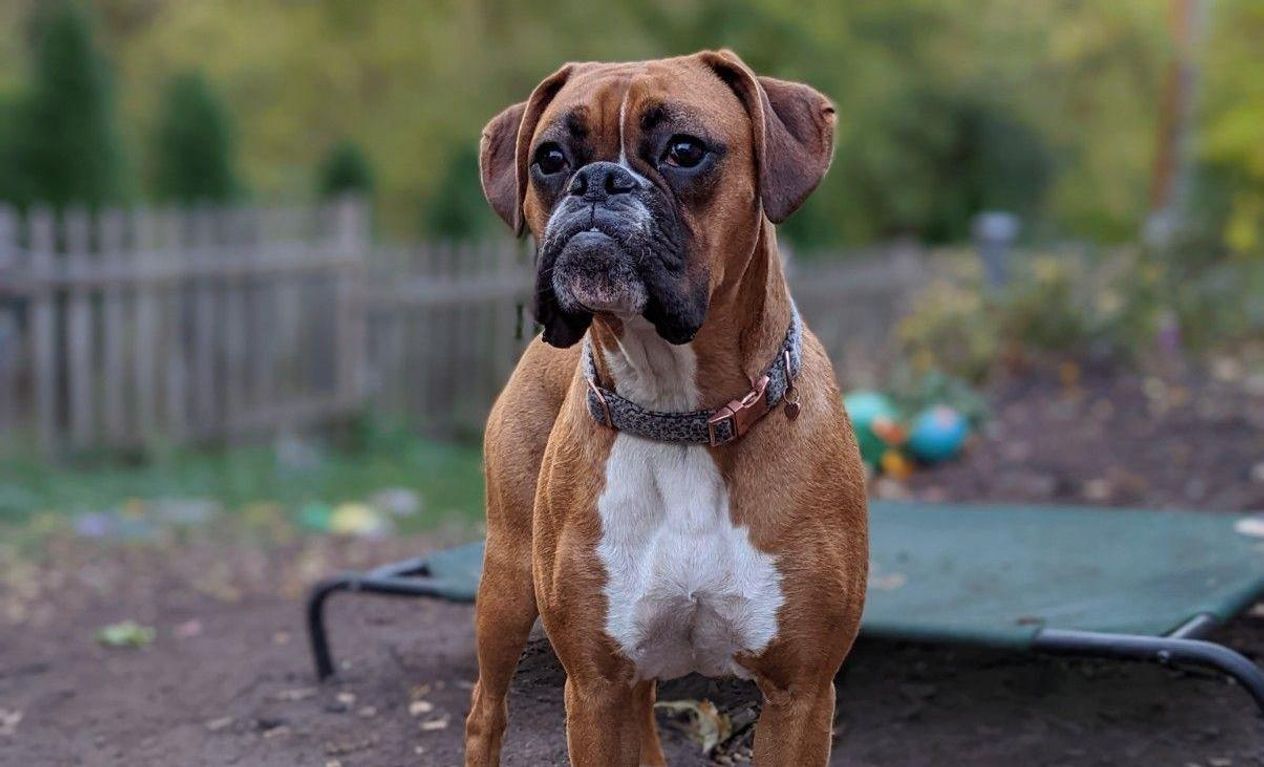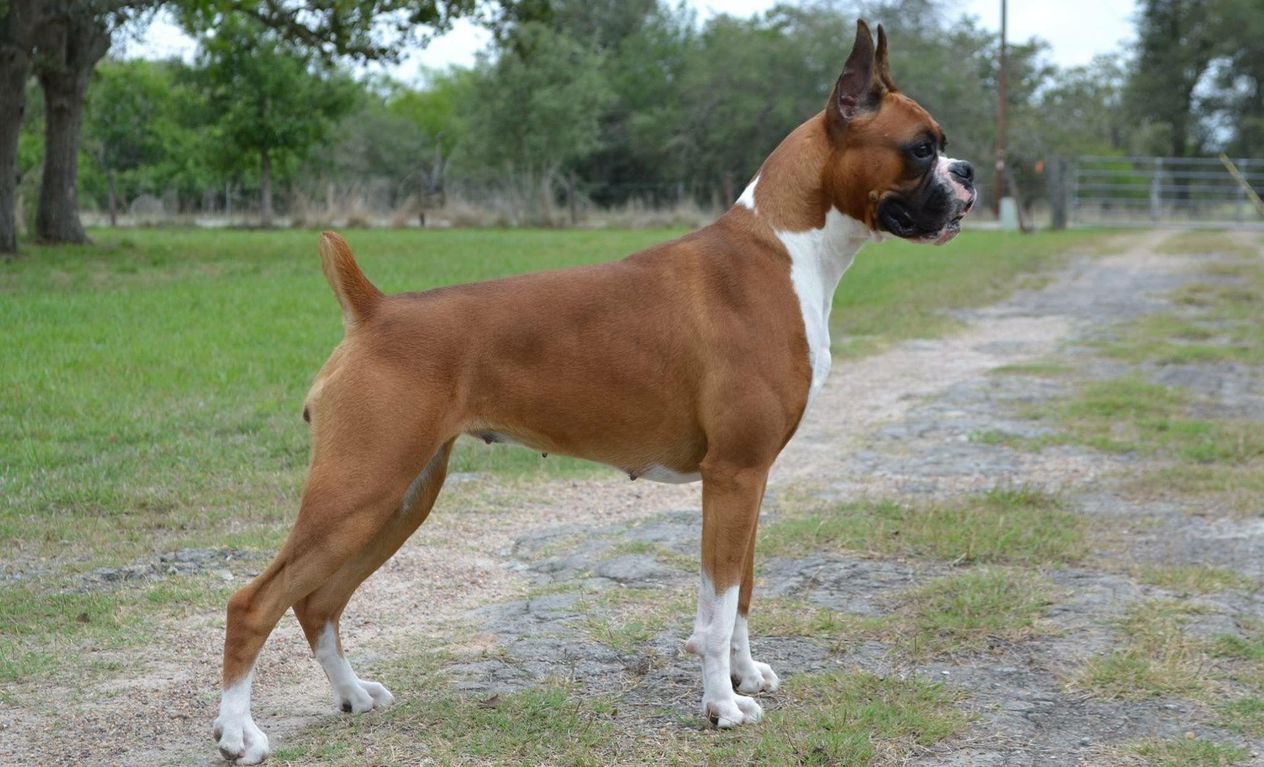Get to know
Boxers

Veterinarian reviewed
Playful, affectionate, courageous, protective, and smart—the Boxer has it all!
Browse available puppies
Connect with reputable breeders to find the dog of your dreams
At a glance
High Energy
Energy level
4/5
Minimal Maintenance
Grooming
1/5
Large
Size
Playful, affectionate, protective
Temperament
10-12 years
Lifespan
Quick to Learn
Training
4/5
Medium Vocality
Barking
3/5
At a glance
Energy level
High Energy
Grooming
Minimal Maintenance
Size
Large
Temperament
Playful, affectionate, protective
Lifespan
10-12 years
Training
Quick to Learn
Barking
Medium Vocality
Why people love the breed
Boxer lovers will always be Boxer lovers. They are loyal to the breed because of their affectionate nature, clownish behavior, eagerness to play, protectiveness, and athleticism. They’re one of the sharpest looking dogs there is.
Appearance
Boxers have a unique appearance. They’re the only large breed to combine a sleek long-legged body with a short brachycephalic head. The Boxer is a dog of contrasts - and the combination works! They are amazingly striking dogs.
Grooming
Boxers are wash-and-wear dogs, requiring minimal grooming.
Chilham Boxers
Breed temperament and characteristics
Owners may be attracted to Boxers because of their appearance, but they love Boxers because of their personality. Boxers are exuberant, interactive, playful, and demonstrative. But they’re not just playmates; they can become fierce protectors when needed.
Exercise
Boxers are energetic athletic dogs that need to run, bounce, and play. They can be destructive if not given a daily outlet for their energy - both physical and mental.
Grand Lake Boxers
Training
Boxers have been trained to the highest levels of obedience. They are alert, smart, and biddable. They learn quickly and generally want to please.
Diet and nutrition
Boxers will thrive on any good-quality balanced diet, whether commercially or home-prepared (following consultation with a veterinary nutritionist).
Moonlite Boxers N Gamprs
Health issues
Every Boxer owner must be familiar with their top health concern, Boxer cardiomyopathy.
Lifespan: 10 to 12 years.
Arrhythmogenic Right Ventricular Cardiomyopathy (ARVC)
Also known as Boxer cardiomyopathy, is a heart condition in Boxers. With ARVC, fatty/fibrous tissue replaces normal heart muscle which leads to electrical instability & arrhythmias, which impact the heart potentially causing fainting, collapse or even sudden death. A DNA test is available. An exam with a cardiologist and use of a Holter monitor can help determine if a Boxer is showing signs and could benefit from any necessary treatment.
Hip dysplasia
This is the most common hereditary disorder of the joints, especially in larger and heavier dogs. It occurs when the head of the femur doesn’t fit snugly into the socket of the pelvis, eventually causing arthritis and lameness. No genetic test is available to date, therefore, the recommended screening test is x-rays.
Cancer
Boxers are at risk for a variety of cancers. Per the breed club, these include malignant skin lesions as well as cancers affecting the brain, thyroid, mammary glands, testes, heart, spleen, blood, lymph system (lymphoma), and other organs.
Degenerative Myelopathy
(DM; SOD1A) is a non-painful, progressive neurological disease. Affected dogs will begin to show signs of weakness of the hind limbs that will progress to complete paralysis.
History
The Boxer was forged by tough circumstances that called for tough dogs.
About the author
Canine specialist, Caroline Coile, Ph.D., is the author of 34 dog books, including the top-selling Barron's Encyclopedia of Dog Breeds. She’s written thousands of magazine and web articles about dogs. She specializes in canine science, health, breeds and competitions. Caroline has won 20 national dog-writing awards, and was a 2015 Inductee into the Dog Writers Association of America Hall of Fame.
Veterinarian reviewed
Dr. Nate Ritter, DVM is the Veterinary Medical Director at Good Dog. He earned his Bachelor of Science in Biology from Lafayette College and his Doctor of Veterinary Medicine degree from Virginia-Maryland College of Veterinary Medicine. He is a member of the American Veterinary Medical Association, New York State Veterinary Medical Society, the Veterinary Medical Association of New York City, and the Society for Theriogenology. Additionally, he is a USDA-accredited veterinarian.
Breed Scorecard
Characteristics and temperament
Affectionate with family
5
Watchdog level
4
Playfulness
5
Adaptability
3
Social needs
4
Temperament
Playful, affectionate, protective, biddable
Intelligence
5
Good with other dogs
3
Good with cats or other pets
3
Friendly with strangers
3
Good as a service dog
4
Good for apartments
2
Barking level
3
Appearance
Height
21-25"
Size
Large
Colors
Fawn, Brindle, White (non-standard)
Coat texture
Smooth
Coat length
Short
Training
Trainability
4
Exercise
Exercise needs
4
Exercise time
1-2 hours daily
Mental exercise needs
3
Favorite activities
Hiking, tug, agility, obedience
Grooming
Grooming needs
1
Brushing frequency
Weekly
Needs professional grooming?
No
Drooling level
3
Health issues
Arrhythmogenic Right Ventricular Cardiomyopathy (ARVC)
Hip dysplasia
Cancer
Degenerative Myelopathy
Other
Bred for
Butcher dog, military dog
Country of origin
Germany
Popularity level
5
FAQs
On Good Dog, you can search for Boxer puppies or dogs in rescues and shelters. Adopting a Boxer from a shelter or rescue is generally less expensive than buying a puppy from a breeder with ethical practices. Across the United States, there are dedicated rescues that specialize in specific breeds and may even help transport a Boxer dog to you from another part of the country. Although it can be more cost-effective, adopting the exact breed you're looking for is typically more difficult than working with a responsible breeder. Learn more about adopting a dog from a shelter or rescue.
How much do Boxer puppies cost? Prices for Boxer puppies for sale vary by breeder and individual puppy. On Good Dog today, Boxer puppies are typically around $2,150. Because all breeding programs are different, you may find dogs for sale outside that price range.
The three different types of Boxer dogs include the American Boxer, German Boxer and English Boxer.
Boxers are low-maintenance when it comes to coat care but fairly high maintenance when it comes to exercise. They can have health conditions, such as Arrhythmogenic Right Ventricular Cardiomyopathy (ARVC).
Boxers are excellent family dogs, offering something for people of all ages. They’re fun-loving friends (and protectors) for children, partners in just about any outdoor adventure for adults, and empathetic bed-buddies to the elderly.



